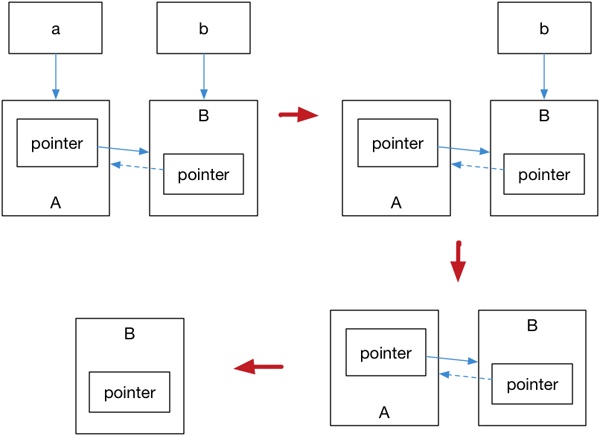
一、RAII 與引用計數
了解 Objective-C/Swift 的程序員應該知道引用計數的概念。引用計數這種計數是為了防止內存泄露而產生的。
基本想法是對于動態分配的對象,進行引用計數,每當增加一次對同一個對象的引用,那么引用對象的引用計數就會增加一次, 每刪除一次引用,引用計數就會減一,當一個對象的引用計數減為零時,就自動刪除指向的堆內存。
在傳統C++中,『記得』手動釋放資源,總不是最佳實踐。因為我們很有可能就忘記了去釋放資源而導致泄露。所以通常的做法是對于一個對象而言,我們在構造函數的時候申請空間,而在析構函數(在離開作用域時調用)的時候釋放空間, 也就是我們常說的 RAII 資源獲取即初始化技術。
凡事都有例外,我們總會有需要將對象在自由存儲上分配的需求,在傳統 C++ 里我們只好使用 new 和 delete 去 『記得』對資源進行釋放。而 C++11 引入了智能指針的概念,使用了引用計數的想法,讓程序員不再需要關心手動釋放內存。
這些智能指針就包括 std::shared_ptr std::unique_ptr std::weak_ptr,使用它們需要包含頭文件<memory>。
注意:引用計數不是垃圾回收,引用計數能夠盡快收回不再被使用的對象,同時在回收的過程中也不會造成長時間的等待, 更能夠清晰明確的表明資源的生命周期。
二、std::shared_ptr
std::shared_ptr 是一種智能指針,它能夠記錄多少個 shared_ptr 共同指向一個對象,從而消除顯式的調用 delete,當引用計數變為零的時候就會將對象自動刪除。
但還不夠,因為使用 std::shared_ptr 仍然需要使用 new 來調用,這使得代碼出現了某種程度上的不對稱。
std::make_shared 就能夠用來消除顯式的使用 new,所以 std::make_shared 會分配創建傳入參數中的對象, 并返回這個對象類型的 std::shared_ptr 指針。例如:
#include <iostream>
#include <memory>
void foo(std::shared_ptr<int> i)
{
(*i)++;
}
int main()
{
// auto pointer = new int(10); // illegal, no direct assignment
// Constructed a std::shared_ptr
auto pointer = std::make_shared<int>(10);
foo(pointer);
std::cout << *pointer << std::endl; // 11
// The shared_ptr will be destructed before leaving the scope
return 0;
}
std::shared_ptr 可以通過 get() 方法來獲取原始指針,通過 reset() 來減少一個引用計數, 并通過 use_count() 來查看一個對象的引用計數。例如:
auto pointer = std::make_shared<int>(10);
auto pointerpointer2 = pointer; // 引用計數+1
auto pointerpointer3 = pointer; // 引用計數+1
int *p = pointer.get(); // 這樣不會增加引用計數
std::cout << "pointer.use_count() = " << pointer.use_count() << std::endl; // 3
std::cout << "pointer2.use_count() = " << pointer2.use_count() << std::endl; // 3
std::cout << "pointer3.use_count() = " << pointer3.use_count() << std::endl; // 3
pointer2.reset();
std::cout << "reset pointer2:" << std::endl;
std::cout << "pointer.use_count() = " << pointer.use_count() << std::endl; // 2
std::cout << "pointer2.use_count() = " << pointer2.use_count() << std::endl; // 0, pointer2 已 reset
std::cout << "pointer3.use_count() = " << pointer3.use_count() << std::endl; // 2
pointer3.reset();
std::cout << "reset pointer3:" << std::endl;
std::cout << "pointer.use_count() = " << pointer.use_count() << std::endl; // 1
std::cout << "pointer2.use_count() = " << pointer2.use_count() << std::endl; // 0
std::cout << "pointer3.use_count() = " << pointer3.use_count() << std::endl; // 0, pointer3 已 reset
三、std::unique_ptr
std::unique_ptr 是一種獨占的智能指針,它禁止其他智能指針與其共享同一個對象,從而保證代碼的安全:
std::unique_ptr<int> pointer = std::make_unique<int>(10); // make_unique 從 C++14 引入
std::unique_ptr<int> pointerpointer2 = pointer; // 非法
make_unique 并不復雜,C++11 沒有提供 std::make_unique,可以自行實現:
template<typename T, typename ...Args>
std::unique_ptr<T> make_unique( Args&& ...args ) {
return std::unique_ptr<T>( new T( std::forward<Args>(args)... ) );
}
至于為什么沒有提供,C++ 標準委員會主席 Herb Sutter 在他的博客中提到原因是因為『被他們忘記了』。
既然是獨占,換句話說就是不可復制。但是,我們可以利用 std::move 將其轉移給其他的 unique_ptr,例如:
#include <iostream>
#include <memory>
struct Foo {
Foo() { std::cout << "Foo::Foo" << std::endl; }
~Foo() { std::cout << "Foo::~Foo" << std::endl; }
void foo() { std::cout << "Foo::foo" << std::endl; }
};
void f(const Foo &) {
std::cout << "f(const Foo&)" << std::endl;
}
int main() {
std::unique_ptr<Foo> p1(std::make_unique<Foo>());
// p1 不空, 輸出
if (p1) p1->foo();
{
std::unique_ptr<Foo> p2(std::move(p1));
// p2 不空, 輸出
f(*p2);
// p2 不空, 輸出
if(p2) p2->foo();
// p1 為空, 無輸出
if(p1) p1->foo();
p1 = std::move(p2);
// p2 為空, 無輸出
if(p2) p2->foo();
std::cout << "p2 被銷毀" << std::endl;
}
// p1 不空, 輸出
if (p1) p1->foo();
// Foo 的實例會在離開作用域時被銷毀
}
四、std::weak_ptr
如果你仔細思考 std::shared_ptr 就會發現依然存在著資源無法釋放的問題。看下面這個例子:
struct A;
struct B;
struct A {
std::shared_ptr<B> pointer;
~A() {
std::cout << "A 被銷毀" << std::endl;
}
};
struct B {
std::shared_ptr<A> pointer;
~B() {
std::cout << "B 被銷毀" << std::endl;
}
};
int main() {
auto a = std::make_shared<A>();
auto b = std::make_shared<B>();
a->pointer = b;
b->pointer = a;
}
運行結果是 A, B 都不會被銷毀,這是因為 a,b 內部的 pointer 同時又引用了 a,b,這使得 a,b 的引用計數均變為了 2,而離開作用域時,a,b 智能指針被析構,卻只能造成這塊區域的引用計數減一。
這樣就導致了 a,b 對象指向的內存區域引用計數不為零,而外部已經沒有辦法找到這塊區域了,也就造成了內存泄露,如圖 1:

解決這個問題的辦法就是使用弱引用指針 std::weak_ptr,std::weak_ptr是一種弱引用(相比較而言 std::shared_ptr 就是一種強引用)。
弱引用不會引起引用計數增加,當換用弱引用時候,最終的釋放流程如圖 2 所示:

在上圖中,最后一步只剩下 B,而 B 并沒有任何智能指針引用它,因此這塊內存資源也會被釋放。
std::weak_ptr 沒有 * 運算符和 -> 運算符,所以不能夠對資源進行操作,它的唯一作用就是用于檢查 std::shared_ptr 是否存在,其 expired() 方法能在資源未被釋放時,會返回 false,否則返回 true。
五、總結
智能指針這種技術并不新奇,在很多語言中都是一種常見的技術,現代 C++ 將這項技術引進,在一定程度上消除了 new/delete 的濫用,是一種更加成熟的編程范式。
到此這篇關于一文掌握 C++ 智能指針的使用方法的文章就介紹到這了,更多相關C++ 智能指針的使用內容請搜索html5模板網以前的文章希望大家以后多多支持html5模板網!
